Optimization of Irrigation Scheduling for Maize in an Arid Oasis Based on Simulation–Optimization Model
Abstract
1. Introduction
2. Materials and Methods
2.1. Study Area and Data Collection
2.2. Soil Water Balance Simulation Model
2.3. Optimization Model for Irrigation Scheduling
2.4. Framework of Simulation–Optimization Model
2.5. Scenario Designs
3. Results and Discussion
3.1. Model Calibration and Validation
3.2. Optimal Irrigation Schedulings under Status Quo
3.2.1. Optimal Irrigation Scheduling for Different Maize Units
3.2.2. Water Balance under Optimal Irrigation Scheduling
3.2.3. Spatial Distribution of Soil Water Consumption, Supply and Crop Yield
3.3. Optimal Irrigation Schedulings under Different Climate Years
3.3.1. Water Balance under Optimal Irrigation Scheduling
3.3.2. Spatial Distribution of Soil Water Consumption, Supply, and Crop Yield
4. Conclusions
- (1)
- The simulation model can reflect the soil water movement of maize filed during the crop growth period in the study area well, with NRMSE less than 6.5% and R2 more than 0.76.
- (2)
- The Pareto solution curve after irrigation scheduling optimization showed a trend of inclining to the upper right, which shows that the yield objective is deteriorating (yield reduction) with the improvement of the water consumption objective (water consumption reduction). The irrigation schedule with the highest point of the Pareto curve (when the yield is the highest) can be selected as the recommended optimal irrigation schedule.
- (3)
- From 2001 to 2010, the irrigation water-saving potential of the study area was between 97 mm and 240 mm, and the average annual optimal yield of maize was over 7.3 t/ha, which indicated that the yield of maize could be obtained after reasonable irrigation scheduling optimization.
- (4)
- The optimal irrigation schedules varied greatly in different typical meteorological years, but the crop yield can be guaranteed between 7.3t/ha and 7.34t/ha. The simulation–optimization model of irrigation schedule established in this paper can provide a technical means for the formulation of irrigation schedules to ensure crop yield and save irrigation water consumption.
Author Contributions
Funding
Acknowledgments
Conflicts of Interest
References
- Michelon, N.; Pennisi, G.; Myint, N.O.; Orsini, F.; Gianquinto, G. Strategies for improved water use efficiency (WUE) of field-grown Lettuce (Lactuca sativa L.) under a semi-arid climate. Agronomy 2020, 10, 668. [Google Scholar] [CrossRef]
- Jeong, J.; Zhang, X. Model application for sustainable agricultural water use. Agronomy 2020, 10, 396. [Google Scholar] [CrossRef]
- Li, W.; Li, Y.P.; Li, C.H.; Huang, G.H. An inexact two-stage water management model for planning agricultural irrigation under uncertainty. Agric. Water Manag. 2010, 97, 1905–1914. [Google Scholar] [CrossRef]
- Chen, D.; Xu, Z.; Chen, R. Design of water resources accounts: A case of integrated environmental and economic accounting. Adv. Water. Sci. 2003, 5, 631–637. [Google Scholar]
- Zhao, C.S.; Huang, L.M.; Shen, B.; Lei, Z.D.; Hu, H.P.; Yang, S.X. The creation of the dissipative hydrological model for Hotan Oasis (DHMHO). J. Arid. Land. Resour. Environ. 2010, 24, 72–77. [Google Scholar]
- The Ministry of Water Resources of the People’s Republic of China. The People Republic of China. Recent Layout Suggestions of Water Resources in the Mainstream of Heihe River; The Ministry of Water Resources of the People’s Republic of China: Beijing, China, 2001.
- Akhtar, F.; Tischbein, B.A. Optimizing deficit irrigation scheduling under shallow groundwater conditions in lower reaches of Amu Darya River Basin. Water. Resour. Manag. 2013, 27, 3165–3178. [Google Scholar] [CrossRef]
- Gu, Z.; Qi, Z.; Burghate, R.; Yuan, S.; Jiao, X.; Xu, J. Irrigation scheduling approaches and applications: A review. J. Irrig. Drain. Eng. 2020, 146, 04020007. [Google Scholar] [CrossRef]
- Xu, X.; Jiang, Y.; Liu, M.; Huang, Q.; Huang, G. Modeling and assessing agro-hydrological processes and irrigation water saving in the middle Heihe River basin. Agric. Water Manag. 2019, 211, 152–164. [Google Scholar] [CrossRef]
- Ran, H.; Kan, S.; Li, F.; Du, T.; Zhang, X. Parameterization of the AquaCrop model for full and deficit irrigated maize for seed production in arid Northwest China. Agric. Water Manag. 2018, 203, 438–450. [Google Scholar] [CrossRef]
- Li, J.; Mao, X.; Shang, S.; Steenhuis, T. Modeling regional soil water balance in farmland of the middle reaches of Heihe River Basin. Water 2017, 9, 847. [Google Scholar] [CrossRef]
- Li, J.; Wang, X.; Bai, L.; Mao, X. Quantification of lateral seepage from farmland during maize growing season in arid region. Agric. Water Manag. 2017, 191, 85–97. [Google Scholar] [CrossRef]
- Singh, A. Simulation–optimization modeling for conjunctive water use management. Agric. Water Manag. 2014, 141, 23–29. [Google Scholar] [CrossRef]
- Shang, S.; Mao, X. Application of a simulation based optimization model for winter wheat irrigation scheduling in North China. Agric. Water Manag. 2006, 85, 314–322. [Google Scholar] [CrossRef]
- Singh, A.; Panda, S.N. Optimization and simulation modelling for managing the problems of water resources. Water. Resour. Manag. 2013, 27, 3421–3431. [Google Scholar] [CrossRef]
- Jiang, Y.; Xu, X.; Huang, Q.; Huo, Z.; Huang, G. Optimizing regional irrigation water use by integrating a two-level optimization model and an agro-hydrological model. Agric. Water Manag. 2016, 178, 76–88. [Google Scholar] [CrossRef]
- Singh, A. An overview of the optimization modelling applications. J. Hydrol. 2012, 466–467, 167–182. [Google Scholar] [CrossRef]
- Li, M.; Fu, Q.; Guo, P.; Singh, V.P.; Zhang, C.; Yang, G. Stochastic multi-objective decision making for sustainable irrigation in a changing environment. J. Clean. Prod. 2019, 223, 928–945. [Google Scholar] [CrossRef]
- Li, M.; Fu, Q.; Singh, V.P.; Liu, D.; Gong, X. Risk-based agricultural water allocation under multiple uncertainties. Agric. Water Manag. 2020, 233, 106105. [Google Scholar] [CrossRef]
- Li, M.; Fu, Q.; Singh, V.P.; Liu, D.; Li, T. Stochastic multi-objective modeling for optimization of water-food-energy nexus of irrigated agriculture. Adv. Water. Resour. 2019, 127, 209–224. [Google Scholar] [CrossRef]
- Li, M.; Fu, Q.; Singh, V.P.; Liu, D.; Li, T.; Zhou, Y. Managing agricultural water and land resources with tradeoff between economic, environmental, and social considerations: A multi-objective non-linear optimization model under uncertainty. Agric. Syst. 2020, 178, 102685. [Google Scholar] [CrossRef]
- Ferguson, J.C.; Krutz, L.J.; Calhoun, J.S.; Gholson, D.M.; Merritt, L.H.; Wesley, M.T.; Broster, K.L.; Treadway, Z.R. Optimizing overhead irrigation droplet size for six mississippi soils. Agronomy 2020, 10, 574. [Google Scholar] [CrossRef]
- Li, M.; Li, J.; Singh, V.P.; Fu, Q.; Liu, D.; Yang, G. Efficient allocation of agricultural land and water resources for soil environment protection using a mixed optimization-simulation approach under uncertainty. Geoderma 2019, 353, 55–69. [Google Scholar] [CrossRef]
- Wen, Y.; Shang, S.; Jian, Y. Optimization of irrigation scheduling for spring wheat with mulching and limited irrigation water in an arid climate. Agric. Water Manag. 2017, 192, 33–44. [Google Scholar] [CrossRef]
- Li, J.; Wan, H.; Shang, S. Comparison of interpolation methods for mapping layered soil particle-size fractions and texture in an arid oasis. Catena 2020, 190, 104514. [Google Scholar] [CrossRef]
- Li, J.; Mao, X.; Li, M. Modeling hydrological processes in oasis of Heihe River Basin by landscape unit-based conceptual models integrated with FEFLOW and GIS. Agric. Water Manag. 2017, 179, 338–351. [Google Scholar] [CrossRef]
- Li, J.; Zhu, T.; Mao, X.; Adeloye, A. Modeling crop water consumption and water productivity in the middle reaches of Heihe River Basin. Comput. Electron. Agric. 2016, 123, 242–255. [Google Scholar] [CrossRef]
- Wang, Y.R. Study of the Transformation of Water in the Field Water Production Function for Winter Wheat. Master’s Thesis, Tsinghua University, Beijing, China, 1996. [Google Scholar]
- Allen, R.G.; Pereira, L.S.; Raes, D.; Smith, M. Crop Evapotranspiration: Guidelines for Computing Crop Requirements; Irrigation and Drainage Paper No. 56; FAO: Rome, Italy, 1998. [Google Scholar]
- Yin, H.; Zhang, B.; Wang, Y.; Zhang, Y.; Wang, Q.; Zhao, Y. Research on the changes trend of crop water requirement in the middle reaches of Heihe River Basin in the recent 43 years. Resourc. Sci. 2012, 34, 409–417. [Google Scholar]
- Lei, Z.D.; Yang, S.X.; Xie, S.C. Soil Hydrodynamics; Tsinghua University Press: Beijing, China, 1988. [Google Scholar]
- Li, T. Pilot study on Water Production Functions and Optimal Irrigation Schedule of Main Crops in Shinyang River Basin. Master’s Thesis, Yangling Northwest A & F University, Shaanxi, China, 2005. [Google Scholar]
- Deb, K.; Agrawal, S.; Pratap, A. A fast elitist non-dominated sorting genetic algorithm for multi-objective optimization: NSGA-II. In Parallel Problem Solving from Nature PPSN VI; Springer: Berlin/Heidelberg, Germany, 2000. [Google Scholar]
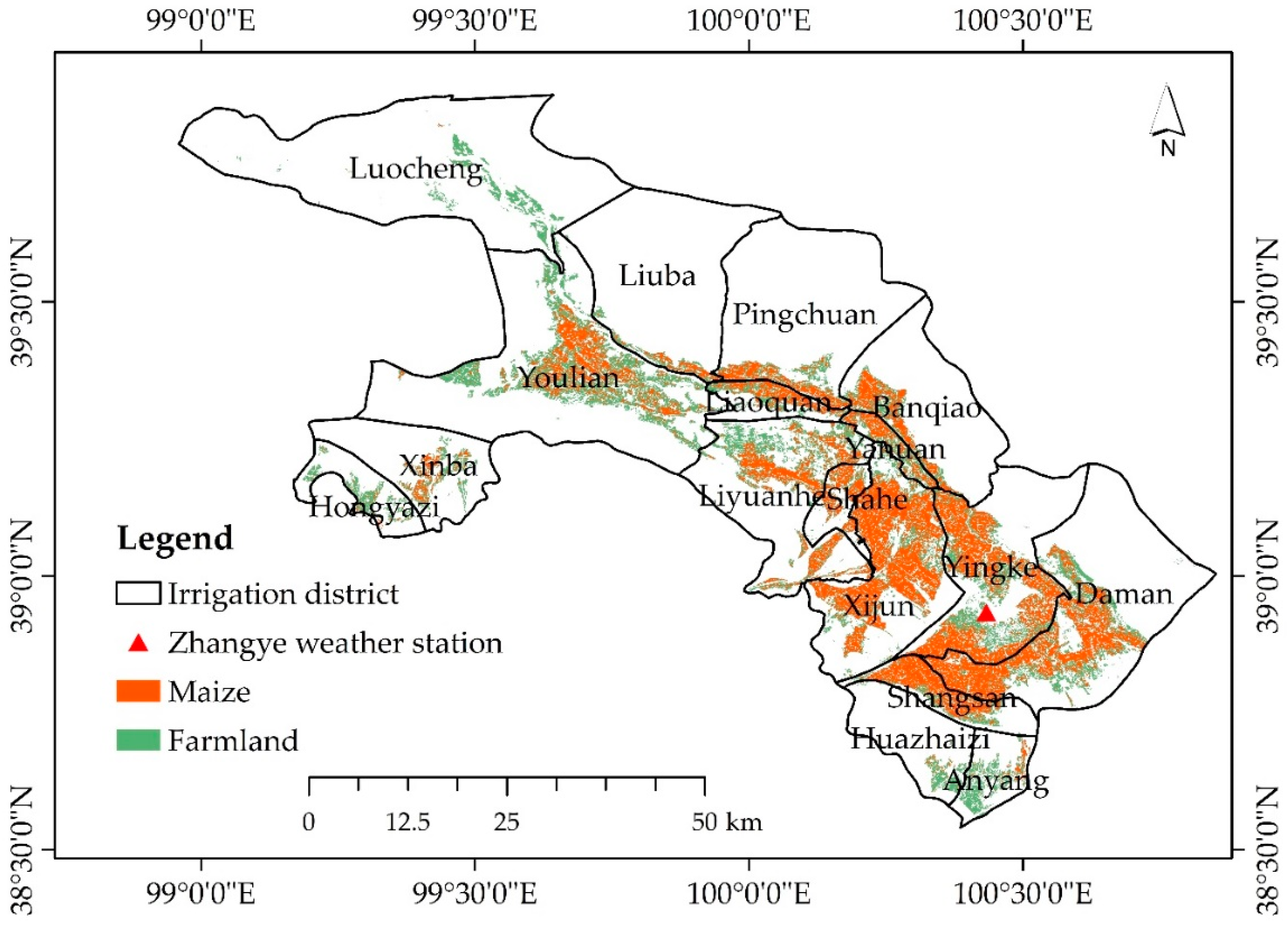
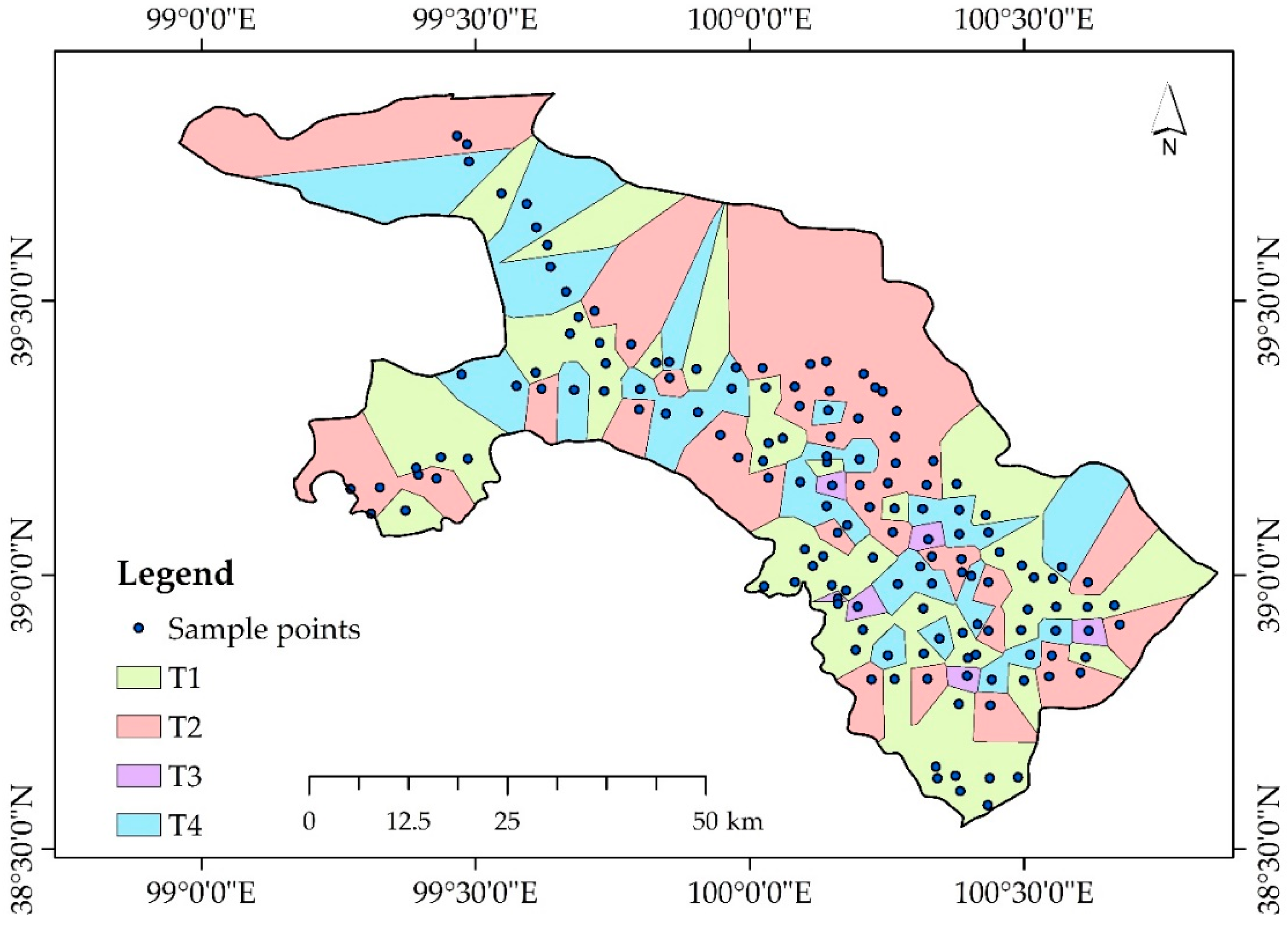
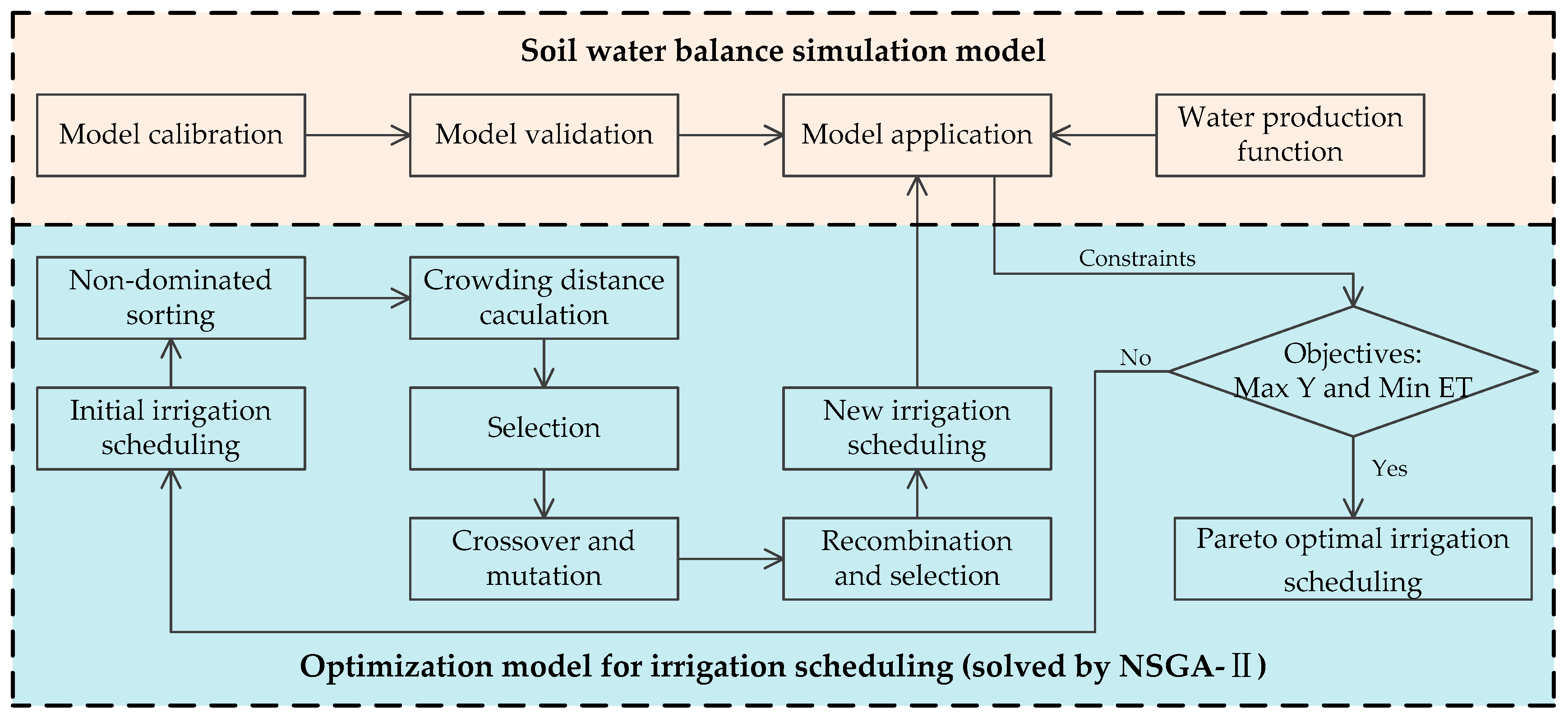

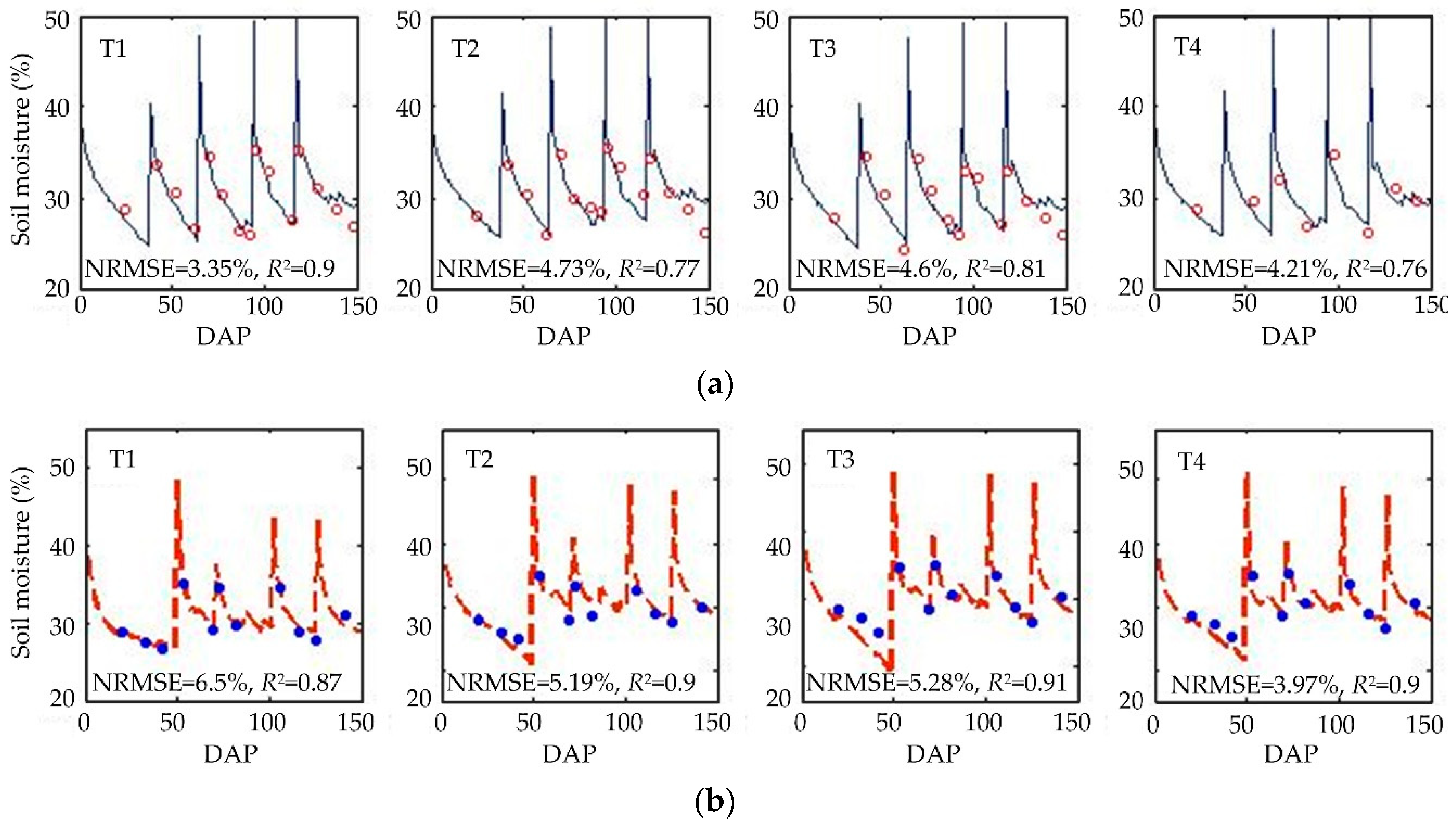
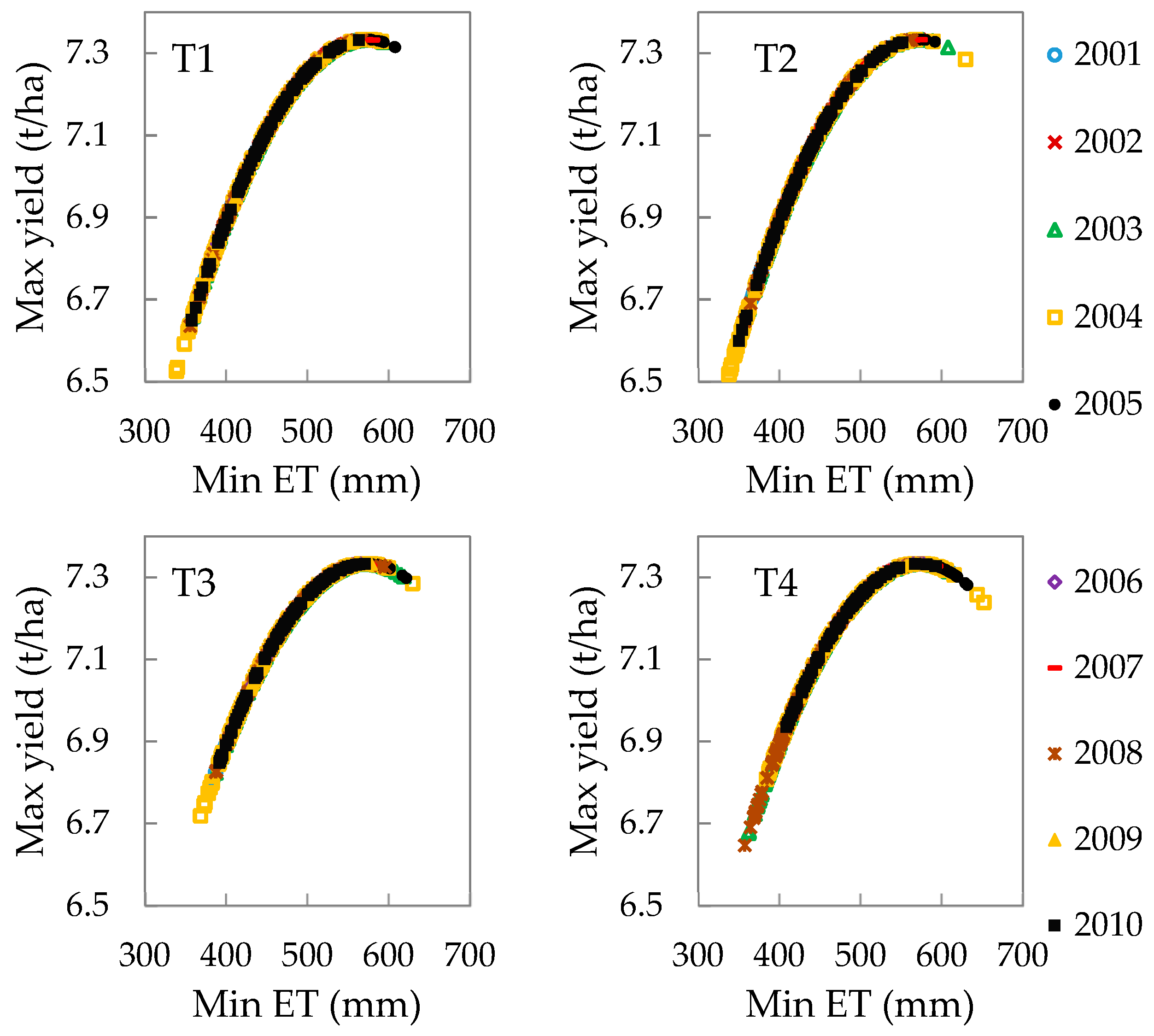
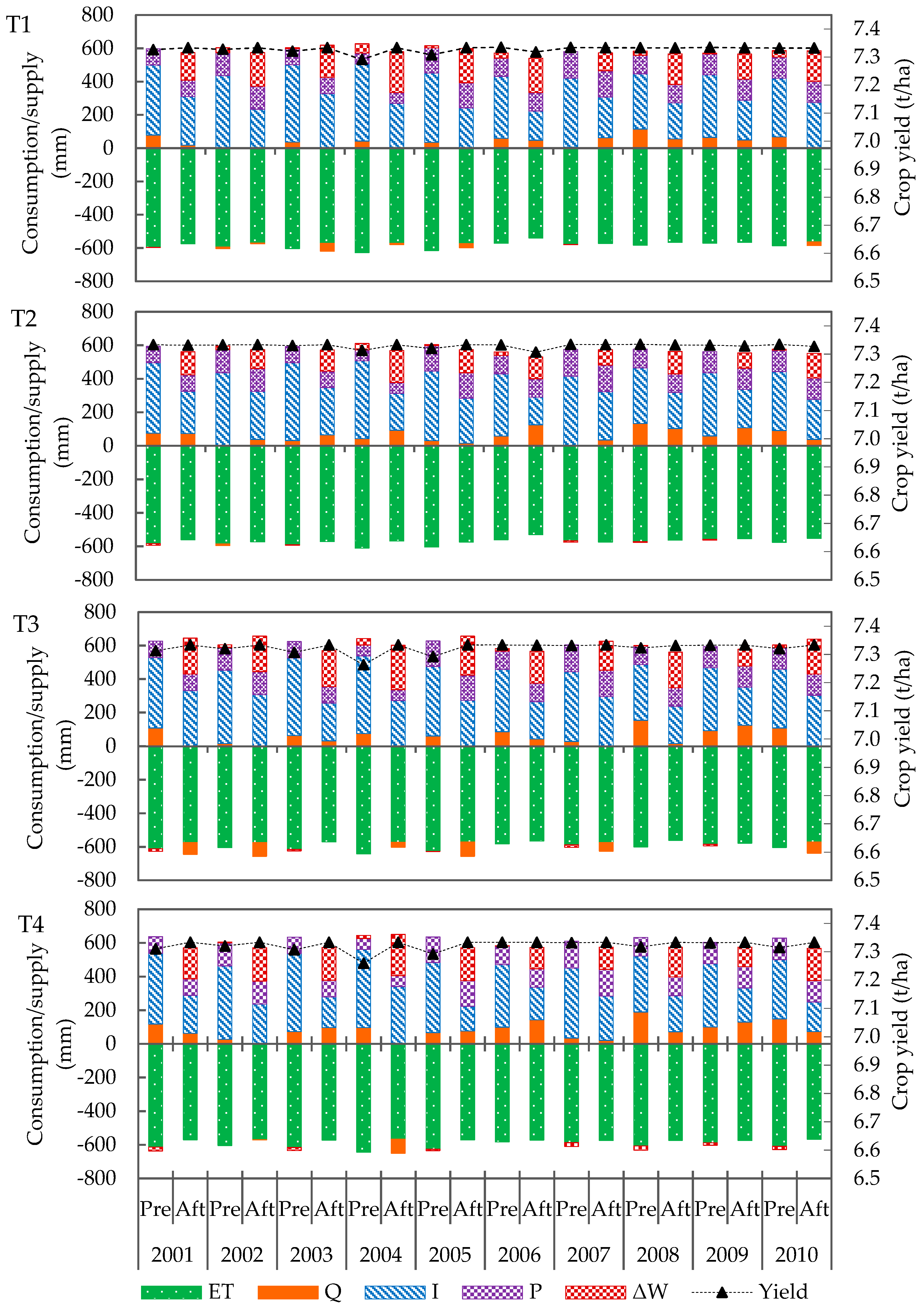
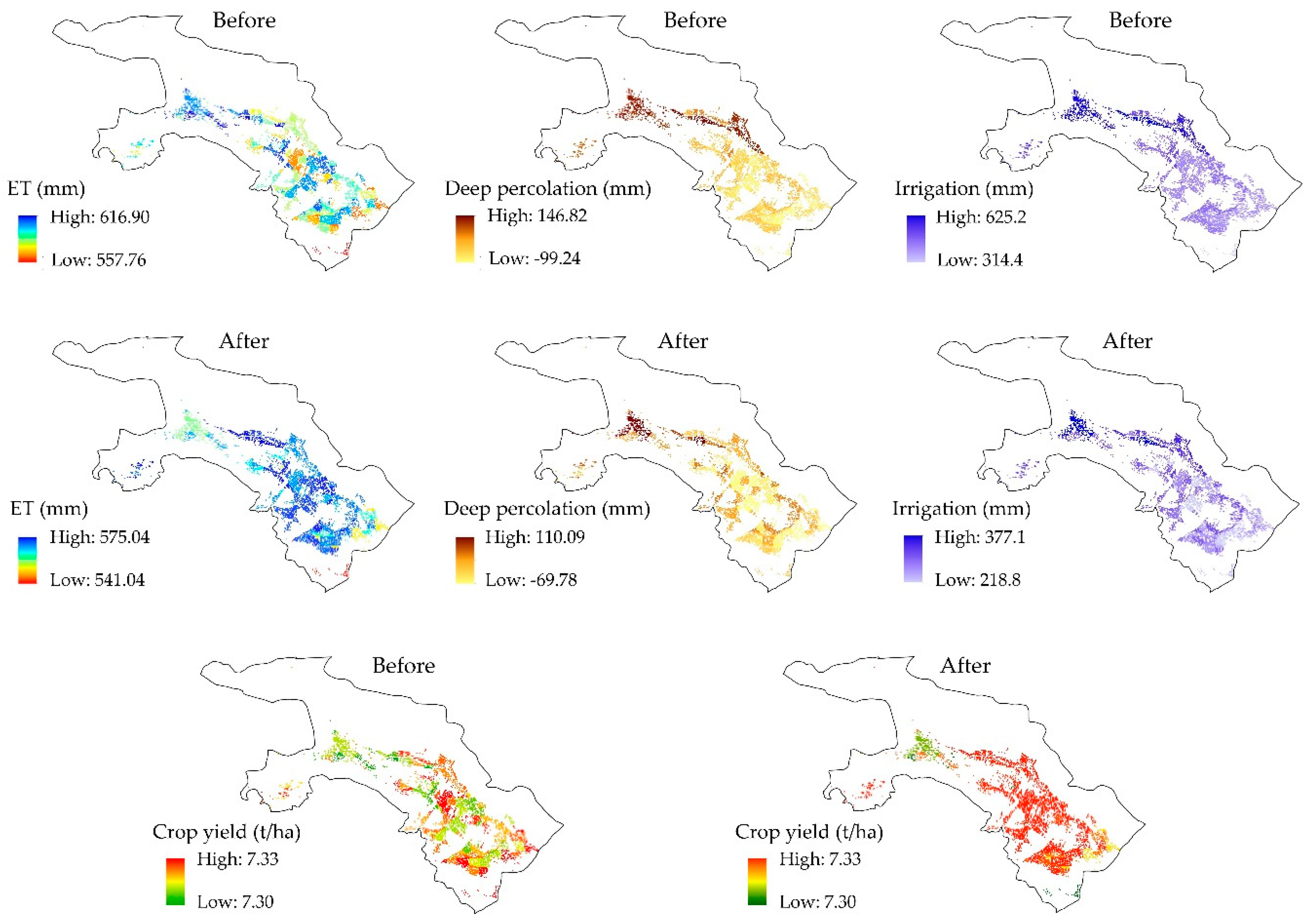


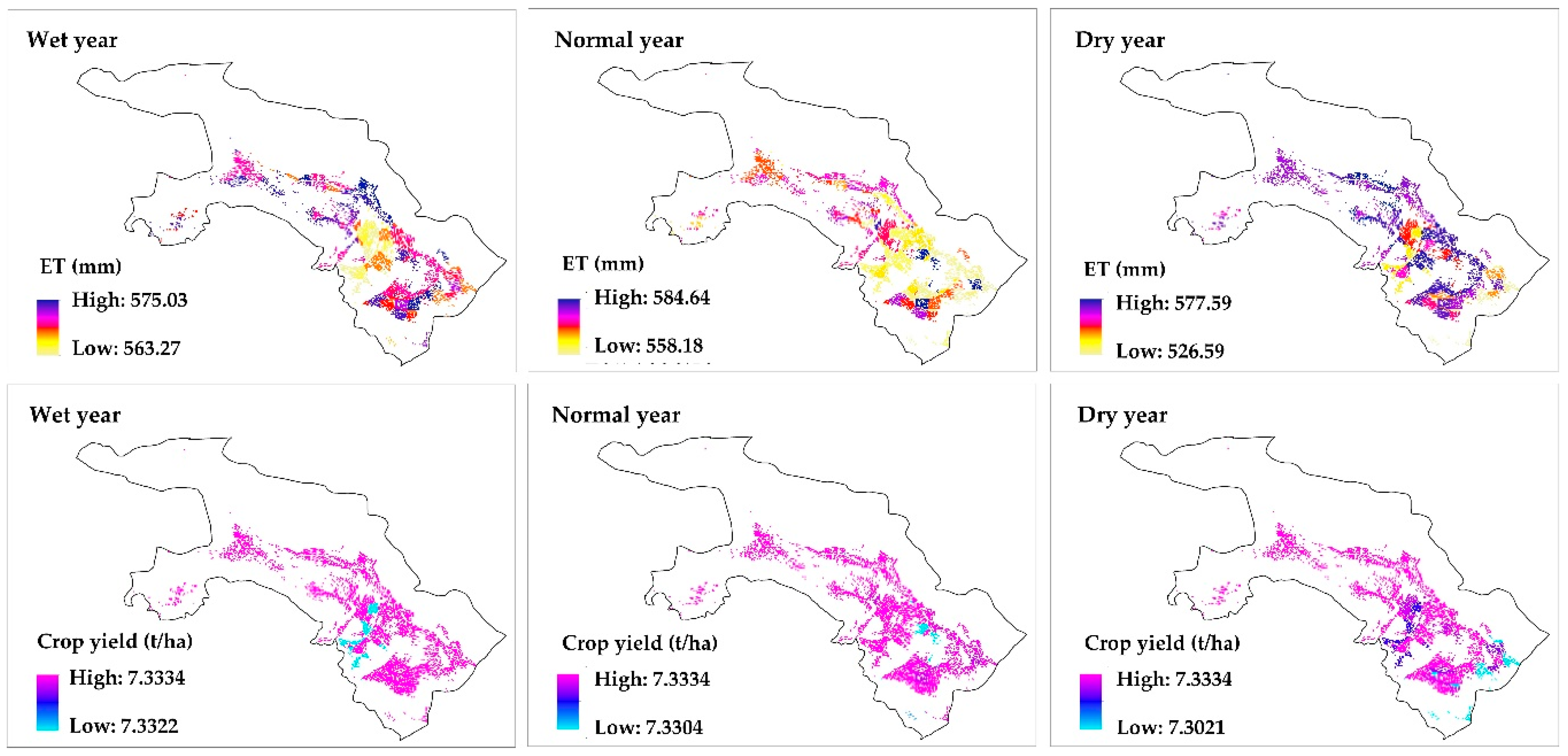
| Soil Type | Soil Texture | |
|---|---|---|
| 0–80 cm | 80–140 cm | |
| T1 | Silt loam | Silt loam |
| T2 | Silt loam | Sandy loam |
| T3 | Silt loam | Loam |
| T4 | Loam | Loam |
| Soil Type | θf (m3/m3) | θc (m3/m3) | θw (m3/m3) | a | b |
|---|---|---|---|---|---|
| T1 | 0.35 | 0.31 | 0.10 | 0.11 | 4.97 |
| T2 | 0.35 | 0.31 | 0.15 | 0.12 | 4.77 |
| T3 | 0.34 | 0.31 | 0.07 | 0.12 | 4.97 |
| T4 | 0.34 | 0.31 | 0.09 | 0.14 | 4.51 |
| Soil Type | T1 | T2 | T3 | T4 | ||||
|---|---|---|---|---|---|---|---|---|
| Irrigation Schedule | Date (DAP 1) | Depth (mm) | Date (DAP 1) | Depth (mm) | Date (DAP 1) | Depth (mm) | Date (DAP 1) | Depth (mm) |
| First irrigation | 30 | 62 | 20 | 47 | 14 | 88 | 9 | 15 |
| Second irrigation | 46 | 51 | 45 | 50 | 44 | 66 | 28 | 14 |
| Third irrigation | 70 | 81 | 66 | 57 | 65 | 87 | 54 | 82 |
| Fourth irrigation | 97 | 80 | 88 | 85 | 95 | 62 | 84 | 65 |
| Climate Years | Soil Type | T1 | T2 | T3 | T4 | ||||
|---|---|---|---|---|---|---|---|---|---|
| Irrigation Schedule | Date (DAP 1) | Depth (mm) | Date (DAP 1) | Depth (mm) | Date (DAP 1) | Depth (mm) | Date (DAP 1) | Depth (mm) | |
| Wet | First irrigation | 25 | 96 | 19 | 72 | 29 | 68 | 22 | 73 |
| Second irrigation | 50 | 90 | 48 | 91 | 51 | 46 | 37 | 18 | |
| Third irrigation | 80 | 49 | 78 | 97 | 81 | 91 | 57 | 59 | |
| Fourth irrigation | 91 | 91 | 91 | 50 | 106 | 54 | 83 | 64 | |
| Normal | First irrigation | 24 | 15 | 24 | 85 | 27 | 66 | 21 | 58 |
| Second irrigation | 53 | 75 | 49 | 72 | 47 | 96 | 37 | 99 | |
| Third irrigation | 76 | 98 | 75 | 98 | 71 | 58 | 61 | 32 | |
| Fourth irrigation | 86 | 26 | 81 | 48 | 93 | 68 | 75 | 87 | |
| Dry | First irrigation | 28 | 57 | 30 | 65 | 29 | 99 | 30 | 56 |
| Second irrigation | 49 | 14 | 44 | 79 | 50 | 76 | 47 | 37 | |
| Third irrigation | 71 | 99 | 56 | 97 | 79 | 72 | 63 | 96 | |
| Fourth irrigation | 94 | 96 | 74 | 99 | 95 | 83 | 72 | 48 | |
© 2020 by the authors. Licensee MDPI, Basel, Switzerland. This article is an open access article distributed under the terms and conditions of the Creative Commons Attribution (CC BY) license (http://creativecommons.org/licenses/by/4.0/).
Share and Cite
Li, J.; Jiao, X.; Jiang, H.; Song, J.; Chen, L. Optimization of Irrigation Scheduling for Maize in an Arid Oasis Based on Simulation–Optimization Model. Agronomy 2020, 10, 935. https://doi.org/10.3390/agronomy10070935
Li J, Jiao X, Jiang H, Song J, Chen L. Optimization of Irrigation Scheduling for Maize in an Arid Oasis Based on Simulation–Optimization Model. Agronomy. 2020; 10(7):935. https://doi.org/10.3390/agronomy10070935
Chicago/Turabian StyleLi, Jiang, Xiyun Jiao, Hongzhe Jiang, Jian Song, and Lina Chen. 2020. "Optimization of Irrigation Scheduling for Maize in an Arid Oasis Based on Simulation–Optimization Model" Agronomy 10, no. 7: 935. https://doi.org/10.3390/agronomy10070935
APA StyleLi, J., Jiao, X., Jiang, H., Song, J., & Chen, L. (2020). Optimization of Irrigation Scheduling for Maize in an Arid Oasis Based on Simulation–Optimization Model. Agronomy, 10(7), 935. https://doi.org/10.3390/agronomy10070935






